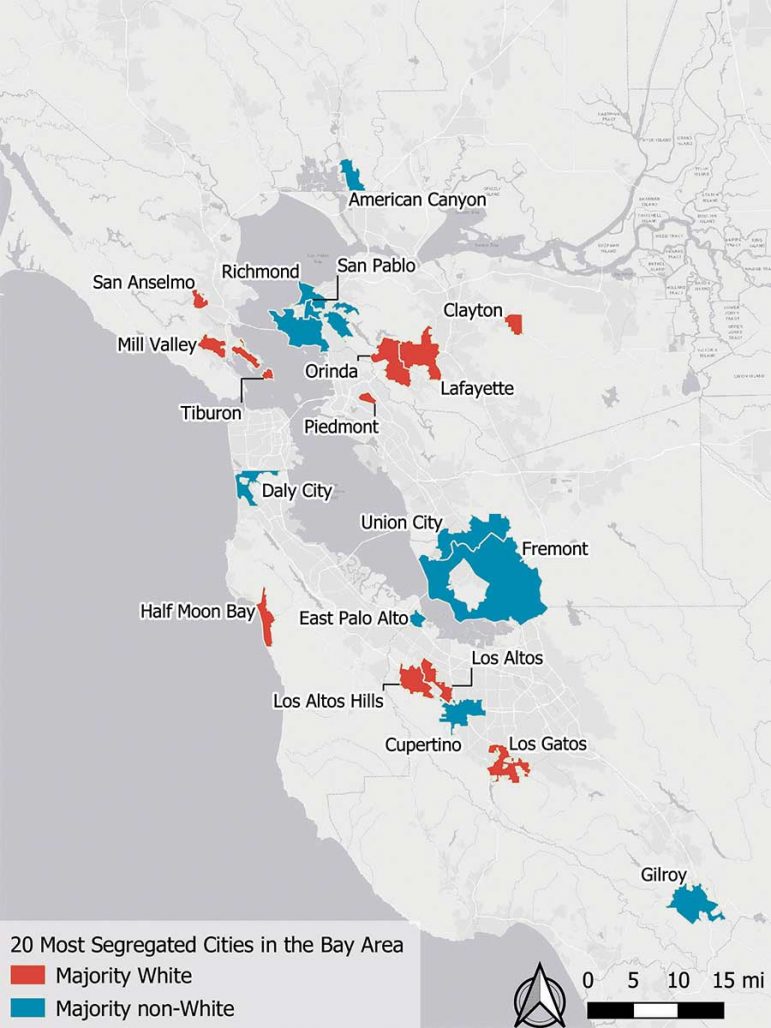As diverse as Oakland is, its neighborhoods are extremely segregated, according to an update to a study by the University of California at Berkeley’s Othering and Belonging Institute.
Of the 10 most segregated Black neighborhoods in the Bay Area, six are in Oakland and of the 10 most segregated Hispanic neighborhoods in the region, five are in Oakland.
The researchers called the finding “stunning.”
Oakland is one of the most diverse and progressive cities in the U.S. But segregation is different than variety or a lack of diversity. Oakland has lots of variety, but also lots of segregation.
“Racial residential segregation is entrenched” in Oakland, “with profound consequences for people of color and their life chances,” the researchers said.
Racial residential segregation appears to affect life outcomes in more than one way. Researchers found for instance that Black children earn nearly $1,000 more per year as adults if they are raised in integrated neighborhoods than if they are raised in highly segregated neighborhoods of color.
Researchers found similar results for Hispanic children.

Highly focused research
The study’s update draws from 2020 Census data to continue an investigation into regional and national segregation and for the first time provides rankings at the census track level, which is a smaller land area than previously analyzed.
At the census tract level, segregation is examined for four racial groups consisting of whites, Blacks, Hispanics, and Asians.
Oakland has more highly segregated Black and Hispanic neighborhoods than any other jurisdiction, but the most segregated census tracts are in San Francisco and San Rafael.
“The extreme segregation of whites into cities such as Piedmont, Lafayette, Atherton, Menlo Park, and Walnut Creek is the result of processes that also segregate people of color in other places,” the report found.
Segregation in San Francisco’s Bayview/Hunters Point neighborhoods is literally off the chart, the study’s lead author Stephen Menendian said, when compared with county-level segregation.
The divergence score, a measure of segregation, for the Bayview/Hunters Point area is higher than 1.0 while the score for the most segregated county in the Bay Area is 0.36. That county is Marin.
San Rafael’s Canal neighborhood, which is a segregated Hispanic neighborhood, also scored above 1.0 in terms of divergence. It is the most segregated Hispanic neighborhood in the Bay Area.
The next four most segregated Hispanic neighborhoods are in Oakland, each with divergence scores above 0.85.
San Francisco’s Chinatown is basically the Bay Area’s most segregated Asian neighborhood. The next three most segregated Asian neighborhoods are in Fremont, based on the divergence index.
The index compares the makeup of an area, such as a neighborhood, to its surroundings.
Pockets of extreme segregation
The top 10 list of most segregated Black neighborhoods in Oakland includes Oak Knoll Golf Links, Acorn, Toler Heights and Foothill Square, the area around Mandela Parkway and Eighth Street, the Lower Bottom neighborhood and the area around Majestic and Outlook avenues, which is part of the Millsmont neighborhood.
Hispanic neighborhoods in Oakland that made that top 10 list include the area around 98th and Cherry avenues, the area around 88th Avenue and Birch Street, the Arroyo Viejo neighborhood, and the area around Bancroft and 82nd avenues.
The study identified cities that are the most integrated rather than segregated. Those include Rohnert Park, Windsor, Petaluma, Pinole, Suisun City and Cloverdale.
Menendian and his team did not look at what those cities did to become integrated, but he said it may have to do with the amount of affordable housing and a lack of poverty.
Three counties in 2020 were more segregated than they were in 2010. Those counties are Marin, Napa, and Sonoma. Seven Bay Area counties were more segregated in 2020 than they were in 1980 or 1990, but racial residential segregation appears to have peaked in 2000 in the Bay Area and declined since then.
